Wild Black Raspberries: Growing, Foraging and Cooking
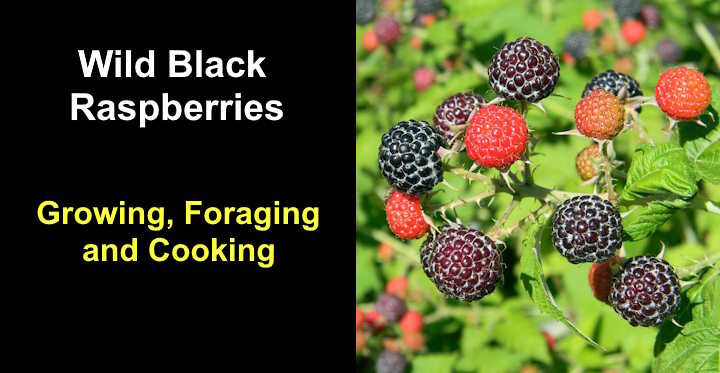
Wild black raspberries are delicious and nutritious fruits you often find in woodlands or along roadsides. The small, black-colored aggregate fruits have a sweet, slightly tart taste and a more robust flavor than red raspberries. Wild black raspberries can be consumed fresh, or used in making pies, jams, juices, or syrups. From their unique flavor to their health benefits, there are many reasons to incorporate wild black raspberries into your diet.
The good news is that wild black raspberries are more than just tasty treats when foraging for wild berries. The canes are easy to grow in fruit gardens or backyards. This way, you can enjoy the delicious black fruit when they ripen in summer. The sharp, thorny canes can act as a security barrier to keep unwanted visitors and wildlife out of your yard.
This article explores everything you need to know about wild black raspberries. You’ll learn about where to find them in the wild and how to grow them in your garden. In addition, you’ll find delicious recipes to try at home.
What Are Wild Black Raspberries?
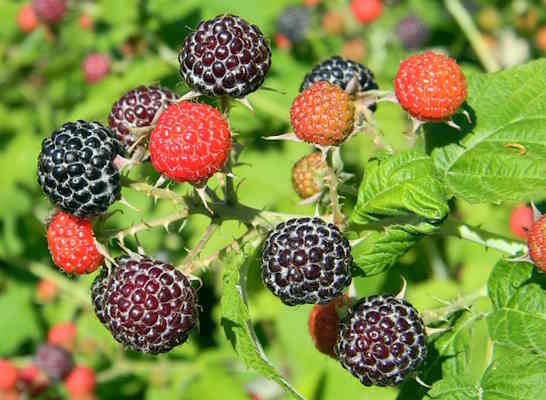
Wild black raspberries (Rubus occidentalis) are the black fruits of a deciduous shrub in the genus Rubus. The fruit is identified as a round to conical shape measuring 0.4” to 0.8” (1 – 2 cm) in diameter. Like all types of raspberries, they have a hollow center and a semi-firm flesh filled with tiny seeds.
Despite the name, wild black raspberries are not a true berry in the botanical sense. Instead, they are a type of aggregate fruit—a cluster of tiny juicy, seed-filed drupelets. They are related to the American raspberry (Rubus strigosus) and the common raspberry (Rubus idaeus). Black raspberries can also refer to (Rubus leucodermis)—a raspberry native to western North America.
Other names for wild black raspberries include black cap raspberry, bear’s eye raspberry, scotch cap, and black cap.
How to Identify Black Raspberries in the Wild
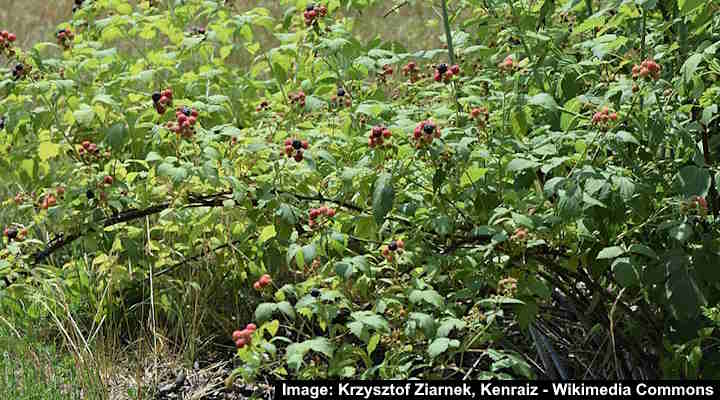
A black raspberry shrub
Wild black raspberries grow on thorny shrubs. The wild edible berries are small, round, blackberry-like fruits that emerge green, turn red, and ripen to dark purple or black in summer. Black raspberry shrubs grow 6.5 to 10 ft. (2 – 3 m) tall with arching stems, lance-shaped leaves, and clusters of white flowers.
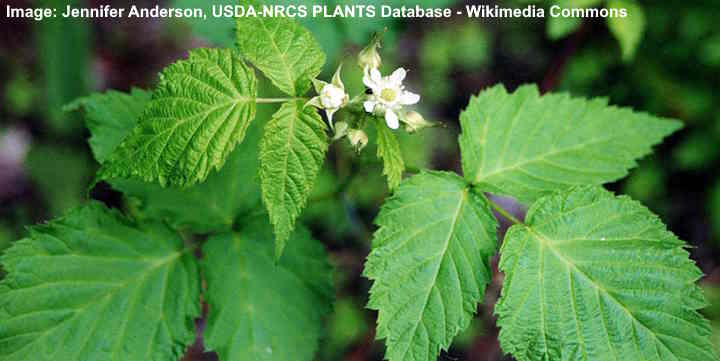
Leaves and flowers of a black raspberry shrub
Leaves on wild black raspberry bushes are palmately compound featuring three or five leaflets. Each leaflet is double-toothed and has a triangular or spearhead shape. The leaves measure 3” to 5” (7.5 – 13 cm) long. Their upper sides are light green, and the undersides are paler, almost white. The slender petioles are slightly prickled.
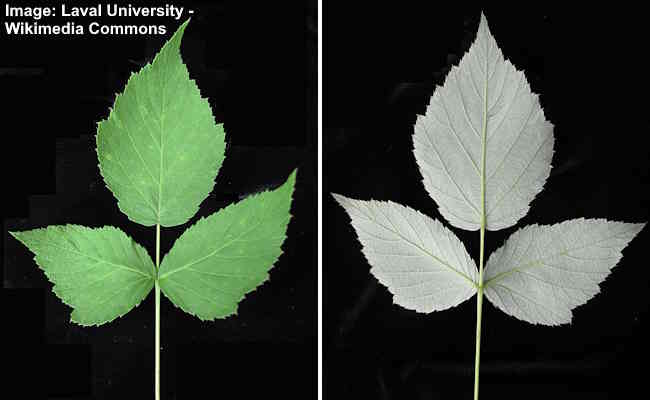
Black raspberry leaves: upper side and underside
Wild black raspberry flowers are white and appear on the prickly shrubs. They bloom in spring for up to three weeks and feature five oblong spatula-shaped petals that spread to form a star shape. The center of the flowers features a crown of white stamens. Raspberry flowers measure 0.33” to 0.5” (0.8 – 1.3 cm) across.
Wild black raspberry fruits are easily identifiable in the wild. However, it’s easy to confuse them for similar-looking blackberries. The round fruits measure up to 0.8” (2 cm) in diameter and have a bumpy surface due to the cluster of juicy drupelets. You can find them growing on arching stems with curved, sharp thorns.
A distinctive feature of wild black raspberries is the waxy white coating that develops on the fruits. The white substance can be easily removed and doesn’t affect the berries’ taste.
Health Benefits of Wild Black Raspberries
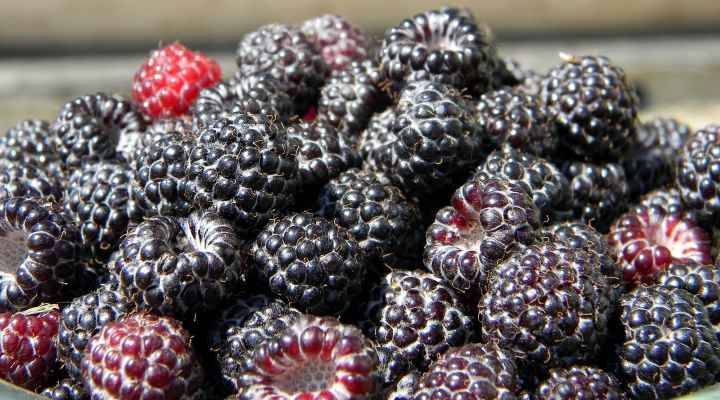
Like all fruits and berries, black raspberries are a good source of vitamins and minerals.
Studies show that raspberries have some of the highest vitamin C content of most fruits. They also have high levels of vitamins A, B, B1, and B2. Additionally, they are rich in macro and micro elements. Some classify raspberries as a superfood due to their rich nutrient content.
Like most dark purple fruits, wild black raspberries contain significant amounts of anthocyanins—significantly more than red raspberries. Scientists link antioxidants like anthocyanins and phenolics with anti-inflammatory properties that can help boost general health and strengthen the immune system.
Black Raspberry vs. Blackberry

Blackberries
Telling blackberries and black raspberries apart can be tricky. Both types of fruits are tasty, sweet, and nutritious, with a deep purple, almost black color. Nutritionally, they have similar levels of vitamin C and fiber. Also, both are soft, perishable fruits with a relatively short shelf life.
The main difference between a black raspberry and a blackberry is the core. Like all raspberries, the fruit readily detaches from the carpel, meaning it is hollow when plucked from the stem. In contrast, the carpel stays within blackberries when harvesting them. Therefore, they have a green or white core rather than hollow.
Another difference between blackberries and black raspberries is their taste. Black raspberries are sweeter than blackberries and red raspberries. Additionally, black raspberries are covered in fine hairs, whereas blackberries are smooth. And unlike blackberries—which are relatively common—black raspberries are harder to find in stores.
Foraging for Wild Black Raspberries
Timing is critical when foraging for black raspberries along hiking trails, woodland edges, and clearings. The arching canes flower in late spring, followed by red fruits that ripen to black raspberries. They are available in midsummer through August. The whitish coating covers dark purple fruits, making them easy to spot.
The fruit-producing black raspberry bushes grow in sunny locations, and you may see red berries together with ripened black fruits. The red unripe raspberries have a tarter flavor and don’t pull off the stems as easily. Because they mature over an extended season, finding large quantities of ripe black raspberries on a foraging trip is challenging.
When foraging for black raspberries, it’s vital to follow sustainable practices. First, you’ll need a good pair of gloves to protect your hands from the sharp spines. Then, you can look for arching canes with lanceolate leaves and serrated margins growing in groups of three or five leaflets.
The best time to harvest black raspberries is early in the morning. At this time, they are cool and plump and won’t be damaged as quickly as when harvested in the afternoon summer heat.
Growing Wild Black Raspberries in Your Garden
Cultivating wild black raspberries in your garden lets you enjoy the summer fruits close to home. Plant the canes in well-drained, slightly acidic soil with ample sunlight. Ensure proper spacing for their arching canes to let the plants spread. The canes require upright supports, and you must prune them annually, starting from the second year after planting.
Let’s look in more detail at how to train and prune black raspberries if you live in USDA Hardiness Zones 4 to 8.
Getting started
The best way to start your fruit garden is to buy small, rooted shrubs that you can plant directly in the ground in spring. Growing black raspberries from seed is possible, but it’s a time-consuming process.
When searching online for black raspberry shrubs, you’ll notice different varieties. For example, ‘Jewel’ is a popular variety for its excellent yield, large-sized berries, and good flavor. You can also purchase thornless types of black raspberries—ideal if you have children who love picking berries.
Where to plant black raspberries
Start by planting the small, rooted shrubs in a row 2 to 3 ft. (0.6 – 0.9 m) apart in the sunniest part of your yard. The planted canes are called a “hill.” It’s vital to ensure you can access both sides of the raspberry bushes.
At the same time, you can install a support system for the arching canes. A 4-foot (1.2 m) post beside each shrub or hill should be sufficient. You can then secure heavy-gauge metal wire or twine between the posts and train the stems to drape over them.
Yearly cycle overview
- First Year (Primocanes): Focus on growth and establishment. No pruning is required. Canes grow vegetatively.
- Second Year (Floricanes): Canes from the previous year bear fruit and then die off. Pruning is crucial after fruiting.
Pruning black raspberries
Pruning black raspberries is essential for maintaining a healthy and productive fruiting plant. Proper pruning helps to improve air circulation, reduce disease risk, and promote new growth. Here are some tips for pruning black raspberries:
Pruning during the first year: After planting, you don’t need to prune the thorny stems for at least 12 months. Train the canes to grow over the trellis or support system as they grow.
Pruning during the second year: The following summer, after planting, you should enjoy a small harvest of delicious black raspberries. Then, in early fall, prune the canes to between 28” and 48” tall (71 – 121 cm). However, it’s good to note that the best harvest results after pruning up to 30” (76 cm). After pruning, loosely tie the canes to the supporting post.
Pruning after the third year: After the third year, you switch to pruning in early spring. Wait until the canes start producing buds and before they leaf out. Here are the three types of pruning methods for a bumper crop:
- First, remove any dead canes.
- Second, thin the canes, leaving four to six of the most robust ones per hill.
- Third, prune the lateral branches, leaving eight to ten buds per branch. Then, loosely tie the canes to the supporting post for each hill.
It’s essential to note that the pruning techniques only apply to black raspberries. Red raspberries have different growth habits and require other pruning methods.
Care and Maintenance
Caring for black raspberry canes involves a combination of watering, fertilizing, and pruning. Keeping the soil consistently moist is vital, especially during hot weather. However, you should avoid over-watering as soggy ground can cause root rot. Mulching around the base of the canes can help retain soil moisture, suppress weeds, and regulate soil temperature.
Regular pruning is vital to maintain healthy black raspberry shrubs. Thinning out any weak or crowded canes improves air circulation and boosts sunlight penetration. Also, removing dead stems prevents disease and helps the shrub focus its energy on growing healthy canes.
During the growing season, be aware of insect pests impacting black raspberry growth. Invasive pests include Japanese beetles, spotted wing drosophila, leaf hoppers, and sap beetles. Raspberry aphids (Amphorophora agathonica) also transmit diseases to plants like raspberry mosaic disease and raspberry leaf curl virus.
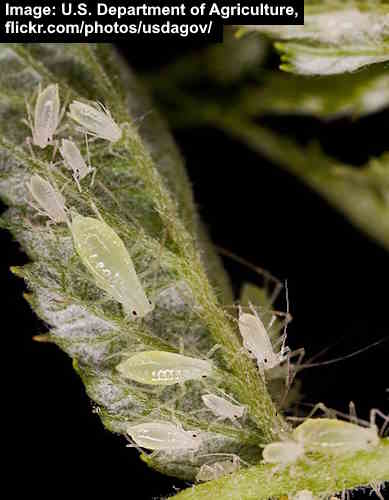
Raspberry aphids (Amphorophora agathonica)
Harvesting Tips
Harvesting black raspberries is a rewarding process. However, the fruits are delicate and easily damaged. Here are some handy tips to ensure you gather ripe berries without injuring yourself, the fruits, or the shrub.
Wear protective gear: Wear thick gloves and a long-sleeved top to prevent the thorns from pricking your skin.
Harvest in the morning: Picking the purple raspberries early in the day helps retain their sweetness and avoid becoming overly soft.
Pick the fruit gently: Give the dark purple or black berries a gentle tug when harvesting—ripe berries come away easily from the canes.
Only harvest ripe berries: Ripe black raspberries are sweet and flavorful. In contrast, unripe red raspberries are tart and have an acidic taste.
Don’t overload containers: Avoid keeping too many fruits in a container to prevent crushing and bruising. If you plan to store the berries, use multiple shallow layers.
Harvest regularly: Black raspberries ripen at different stages over the season, even on the same shrub. Regular harvesting ensures you always have delicious berries and stimulates new berry production.
From Field to Table – Utilizing Your Harvest
Unless you consume black raspberries directly from the bush, you need to find ways to use or preserve black raspberries. The sweet, juicy berries have a relatively short shelf life.
Preservation techniques
Two ways to store fresh black raspberries are in the refrigerator or freezer. Regardless of your method, you should inspect the fruits for signs of mold and discard any damaged or mushy ones. Also, the delicate fruits are best stored in shallow containers in a single layer.
Storing black raspberries in the refrigerator: Place the black berries in a vented container and store them in the fridge. However, only wash them before consuming them, as the extra moisture can make them deteriorate quicker. Raspberries should keep fresh in a cold, dark place for a few days.
Storing black raspberries in the freezer: For long-term storage, freeze your crop of black raspberries. Put them in a colander and rinse with cold water to prepare them for freezing. Lay them on paper towels and pat them dry. Then flash-freeze them this way:
- Place a single layer of berries on a baking sheet in the freezer for two hours.
- Transfer them to an airtight container or freezer bag.
- Repeat the process if you have more berries that didn’t fit in the first batch.
- Add them to the other berries in the freezer bag.
This preservation method ensures the berries won’t stick together when stored for later use. They can be stored for up to 12 months. You can then thaw the berries before adding them to fruit salads or using them in baking. However, you can put frozen purple raspberries directly in the blender to make smoothies or ice cream.
Culinary ideas for using black raspberries
Wild black raspberries are delicious and versatile fruits. Some people say they taste better than red raspberries because they are sweeter and juicier. Also, they are not as tart as blackberries. So, besides eating them raw as a tasty and healthy snack, how else can you use the delicious dark purple fruits?
Here is a list of a few ideas for using this “wild food”:
- Berry parfait with layers of purple raspberries and Greek yogurt with honey drizzled over the top.
- Green berry salad with black raspberries, leafy greens, vinaigrette, and feta cheese.
- Berry sauce by heating the dark raspberries with some sugar and water and drizzling over desserts.
- Infused water or lemonade by putting black raspberries in a refreshing beverage.
- Savory accompaniment by using the sweet berries along with grilled meats, goat’s cheese, or salads
Wild Black Raspberry Recipes
Black Raspberry Jam: To make jam, you’ll mix the wild black raspberries with sugar and a bit of pectin. The mixture is cooked until it reaches the desired thickness before cooling and setting. This creates a delicious homemade jam that’s perfect for spreading on toast or incorporating into desserts.
Wild Black Raspberry Cobbler: Create a filling with the berries, a sprinkle of sugar, and a dash of lemon juice for acidity. Cover this mixture with a simple biscuit dough and bake until the topping is golden brown and the berries are bubbling. Serve warm for a comforting dessert.
Smoothies: Combine the wild black raspberries with creamy yogurt, a ripe banana for sweetness, and a splash of milk to blend everything to a smooth consistency. This creates a nutritious and refreshing drink.
Salad Dressing: For a unique dressing, puree the berries and mix with olive oil, your choice of vinegar, and a touch of honey for sweetness. This dressing adds a bright, fruity flavor to any salad.
Black Raspberry Ice Cream: Puree the raspberries and fold them into your base mixture for ice cream. After freezing, you’ll have a rich, creamy dessert with the delightful taste of wild black raspberries.
Wild Black Raspberry Pie Recipe
Ingredients: 4 cups wild black raspberries, 1 cup sugar (adjust to taste), 3 tablespoons cornstarch, 1 tablespoon lemon juice, pie crust (top and bottom).
Directions: Preheat the oven to 375°F. In a bowl, mix raspberries with sugar, cornstarch, and lemon juice. Pour into the bottom crust. Cover with the top crust, seal edges, and make slits for steam to escape. Bake for 45-50 minutes until the crust is golden brown. Let cool before serving.
This concise recipe captures the essence of using wild black raspberries in a traditional dessert, perfect for incorporating into a broader article on the subject.
Wild Black Raspberries: FAQs
How rare are black raspberries?
Black raspberries are relatively rare in the wild and only cultivated commercially in Oregon. Because of their short shelf life, they are typically only available for three weeks in the summer. Therefore, they are classified as rare, specialty, seasonal fruits with limited availability.
Where do black raspberries grow in the US?
Wild black raspberries grow throughout North America. The variety Rubus occidentalis thrives in disturbed sites, meadows, beside woodland pathways, and near streams, ponds, and lakes. Eastern black raspberries are found as far west as Nebraska. The variety Rubus leucodermis is native to western North America. It is located in habitats similar to the eastern black raspberry.
Related articles:
